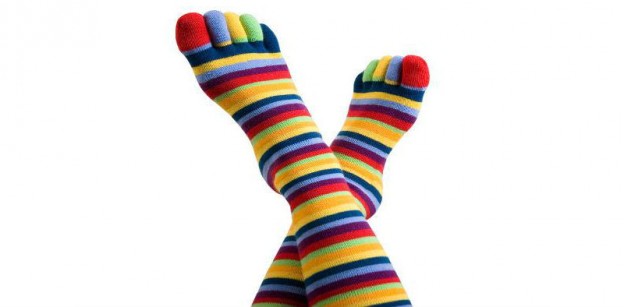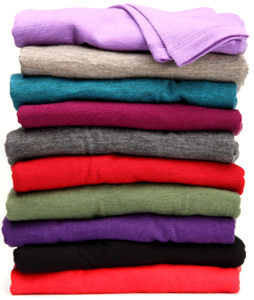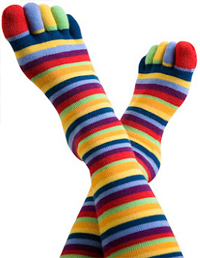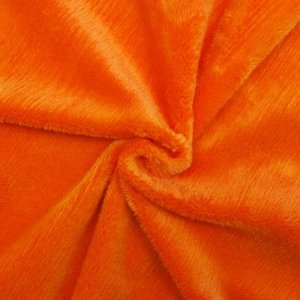
11 More Tips For Dressing Your Sensory-Sensitive Child
Recently I wrote a post giving 10 Tips for dressing a sensory sensitive child.
After this post was written we asked the special needs community on Facebook, Twitter and LinkedIn if they had any additional tips for dressing a sensory child.
Sensitive adults and parents of sensitive children responded with their experience and recommendations. Some adults reported that their clothing sensitivities are much more manageable now than in childhood.
All of the responses shared a desire to help our children find comfortable clothing and increase their sensory tolerance. These are their real-life solutions to clothing sensitivity.
1. Be Patient And Choose Your Battles
MB: “Sometimes it helps if people are exposed to clothing for a few weeks before they are required to wear it. Just having it around, seeing, smelling, feeling it may all have to come before wearing it.
Sweaters are a perfect example. I can love a sweater at the store, and once I get it home and start wearing it, then it all changes and I notice all kinds of irritating things about it. I was just smitten with it at the store, but can't wear it for real.”
Elizabeth: “Just remember to be patient with the children because it is not their fault and they can not help it.”
Kellie: “My son is 7 and doesn't like jeans or rough-feeling clothing. Track pants, t-shirts, etc. are his favorite. Loose, baggy shorts are his preference and getting underwear on is still tough. I have to remind him every morning or he tries to leave the house without them on.
Clothing is always an issue - and the first thing he does when he comes home from school is to take everything off! He starts in the car as soon as he's left school, and by the time we are home (1 mile away), he's down to just a pair of shorts, and usually they are off before he makes it to his bedroom.
Many weekends he stays naked all weekend; but that's our compromise - clothes for school, going out and when people are in the house, and it’s OK to be naked if it’s just us.”
Denise: “My daughter is 20 now, and although she still continues to love old, soft, comfortable clothing, she has learned that those clothes aren't always appropriate. And even though I despaired at times that she would never stop wanting to wear only sweatpants, at some point she decided jeans were much more cool, and that's what she wears most of the time now when out in public.
My advice is let them wear what they want as long as it covers what needs to be covered and is clean! There are too many issues that you'll need to struggle with, and this isn't one of them!”
2. Trial And Error
Erik: “The main thing is trial and error, because one child will go totally mad for denim, cotton or synthetic fabric, the other will get a fit of silk.”
Elizabeth: “I can not wear anything that touches my neck too tightly like a crew neck t-shirt or turtleneck.”
Emily: “I was really sick of navy and black turtlenecks but that's what he wore for a while - year round. Maybe you can move into a few different colors to mix it up.”
Dawn: “My friend's daughter wears spandex leggings and tops under her clothes. I like to wear socks that cover the ankle because I can't stand feeling my shoe laces touching them. When buying t-shirts for my son I make sure there is no embroidery that can be uncomfortable on the underside. Here are a few articles that address sensory dressing issues along with some strategies.”
Tania: “Try clothing made from bamboo - it's very soft. Also avoid clothes with small neck holes.”
3. Stock UpDavid: “Foam ear plugs. Won't leave the house for a movie or concert without 'em!”

Becky: “I might suggest that once you find the clothing item that is comfortable you buy them in 1/2 sizes to last a couple of years. I did this with a preferred pair of boots for my daughter, 4 pairs, each a half size larger. This boot limited the arguing for 2 years!”
Collette: “To this day, my son (23) will not wear long-sleeved anything except for a coat, and we live in northern Wisconsin. I suggest tagless everything. We cut tags and tags, and when he was young, he wore sweatpants and t-shirts everywhere.”
Debi: “FunandFunction.com has a GREAT line of sensory clothing that doesn't just feel great but looks pretty cool, too. ‘Hug’ t-shirts, seamless socks, tagless clothing, etc. Otherwise the main guidelines in my house are soft, soft material, sweats, NO turtlenecks, NO zippers, NO buttons, NO snaps, NO buckles... but now that he homeschools he hangs out in his boxer briefs more than anything.”
Melinda: “When I find a style he loves, I go back and purchase more in the next size up. Meanwhile, we work on flexibility for occasions where that casual dress is not appropriate, such as weddings or funerals.”4. Get Rid Of Lumpy Socks
 Mary: “My son had a big issue with socks. I got the seamless socks from Striderite and they worked really well. They are expensive but they last!”
Mary: “My son had a big issue with socks. I got the seamless socks from Striderite and they worked really well. They are expensive but they last!”
MB: “I will also attest to 20 years of wearing the World's Softest Socks (that is the name of the brand!) You can find them online. I hate summer and have a hard time transitioning out of wearing socks.”
Elizabeth: “I had to have tight straight, thin socks because if there were any bumps in the I would rip my socks off because I felt like I was crawling out of my own skin.”
Sandra: “Seamless socks: found on diabetic websites. Tag less clothing: various clothiers. To remove tags, use a seam cutter.”
5. Laundry Detergent and Chemical Sensitivity
Emily: “Finding a good laundry detergent with no scent and non-itch inducing/nonirritating, and no fabric softener and no dryer sheets to prevent fabric pilling also helps to keep his favorite clothing feeling the same over time.”
Karen: “My husband gets a rash every time he is exposed to scented detergents, so we only use laundry detergent that is free and clear of dyes and perfumes. No dryer sheets or fabric softeners here, and we always add an extra rinse cycle to remove excess detergent.”
Erik: “In some denim, they put this chemical stuff that makes me bleed in my kneepits and loins, so I have to be careful with tight fitting trousers.”
6. Work on the Process of Dressing
 Emily: “Process can be important. While he was young we always got him dressed in the same order undies, shirt, pants, etc. in the same room like a ritual to make it a predictable and more comfortable event.”
Emily: “Process can be important. While he was young we always got him dressed in the same order undies, shirt, pants, etc. in the same room like a ritual to make it a predictable and more comfortable event.”
Tory: “If your child has trouble crossing the midline, please experiment with putting on clothes starting with a favorite side of the body: right arm, head, left arm... sometimes that makes a difference in tolerance as well.”
7. Color and Shapes
Erik: “I have an allergy to V-collars because I just cannot stand the shape. But at the same time, round collars that are too tight make me heave.
As a kid, there were only 2 possible colors for my clothes: dark blue and less dark blue. At some point and to the delight of my parents, black, brown and green also got my liking. Other colors I just flatly refused to wear.
Only when I reached the age of about 21, I started to get over that - I got overworked in a depression, and then I somehow got it into my consciousness that colors could be used actively, also in clothes. And when I realised that, to the complete disbelief and shock of my parents, the first thing I bought was this big fire truck red ski-coat.
And after that, I also started to wear yellow shoes, red trousers, pale or fiery green, blue, yellow and red sweaters, because I sensed those colors helped me to get over my depression. By the way, this was in the '80's when such colors were all the rage in street fashion...I still start to wear such bright colors if I feel I go downhill. Normally I wear dark colors, but the obsessive choice is removed from it.”
Emily: “Smooth, soft, and gray pretty much describes his wardrobe. Jeans and tees, gray hoodie - year round.”
8. Emotion and Texture
Erik: “I seem to be an exception in that I absolutely love the feeling of sheep’s wool on my bare skin. Silk and satin and very soft synthetic fabrics to me are overwhelmingly, addictingly attractive in their softness and movement. If I wear clothes of that kind of fabric (running gear, sports clothes are made of very soft synthetic fabric) I have to be very careful not to 'freeze' and get lost in myself, in my experience, into just sensing that cloth on my skin. As a kid, my parents have 'lost' me that way on several different occasions.”Elizabeth: “I still have sensory issues as an adult although very minor now, but it started early in my life. I hated wearing jeans because of the roughness against my legs and the seams (never would wear them).
I had to mostly wear 100% soft cotton and preferred to wear dresses so it wasn't so clingy to me. Same thing goes for tags in shirts, I would have my mom cut them out or break the stitching in the shirts to totally remove them.
I still have some of these issues as an adult. I would say to try the seamless socks, soft cotton tagless shirts, and soft comfortable elastic waste shorts etc. I don't know how old your child is but I would experiment letting them help you to get them dressed and feel like they are more in control of what is happening.
This may help to feel more secure and they can take their time. I know it can be a really icky feeling when something doesn't feel right on your skin/body. I still hate walking barefoot because if one little spec of sand is on my foot it drives me absolutely mad.”
9. Heavy, Warm Fabrics And Clothing
 MB: “Fleece has been my saving grace. Fleece sheets are the answer to my prayers. Long underwear is good to provide a bit of pressure and consistency if it is nice and cold out.“
MB: “Fleece has been my saving grace. Fleece sheets are the answer to my prayers. Long underwear is good to provide a bit of pressure and consistency if it is nice and cold out.“
Erik: “From early on and to this day, I have several issues with clothing. Heavy clothing gives me a feeling of security, of protection. So I tend to wear ever more heavy clothing at times when I feel insecure in life or when my senses stand to 'open.' Heavy denim trousers or even leather trousers, heavy army boots, heavy leather coat, heavy and rough feeling woolen pullover, cap or bonnet- that kind of clothing.
Clothes that are inevitable to feel on my skin and body will put a sensory-preoccupying layer between me and the rest the world. I need that to keep focused, to prevent being overwhelmed by other incoming information, just like people use personal music (mp3-player and such) to have a protective cocoon. Or just like a mobile weighted blanket such as you use at night in bed.”
Karen: "My son does not like the feeling of air on his arms or legs. He prefers long sleeves and long pants year round, and he prefers sweaters or heavy fabrics. At home he likes to wrap himself in a thick fleece blanket, even in summer. Being covered gives him a feeling of security."
10. Be Wary Of Seams
Tory: “I prefer pull-on clothing, all with what they call french finish on the seams so they don't stick out. Or undershirt on inside out to protect the skin from a shirt that may have irritating seams. I was irritated by and allergic to so many things as a kid. I have gotten so much better. Your child will, too.”
Emily: “Dressing my baby son was not generally easy, as he would pull his clothes off as quickly as I could get them on. He could not stand anything on his feet and was very sensitive to clothing (and the world at large).
Almost everything he wore when he was little was knit, soft, or was peculiarly outrageous but appealed to him in some way. Clothing worn inside out helped as it kept seams away from his skin (socks, undies/boxers, tees, pjs, sweats, sweatshirts, etc). He is a teen now and he still prefers to wear the seams outward or find clothes constructed with an inside out look.”
Melinda: “My child lives in the C9 line of clothing by Champion at Target. They have minimal seams.”
Erik: “Sharp or prickly seams can drive me over the edge so that right then and there I can ruin a new garment just to get it out.”
11. A Sense Of Control
Erin: “Our biggest one was to let him pick out his own clothes and what he wanted to wear (we had issues with seams and tags, plus he prefers certain types of clothes over others). SO if he wants to wear docker type pants instead of jeans so be it. Tagless shirts and underwear are a godsend. I was always pulling tags out of my own shirts.
But I think really the biggest thing as a part we can do is not fight the sensory stuff. I have a kid that would wear his hood up on his winter jacket even indoors, wouldn't get his hair or face wet, couldn't get his hair cut, etc., and when we turned it over to him and gave him as much control over it as possible, things got better on his time, not ours.”
Lucy: “When he was younger, our son preferred sweat pants with very soft fleece on the inside and seamless socks. So sweat pants and tube socks it was!”
Kellie: “He hates tags on his clothes - we have to cut them all off! We have lots, and lots and lots of clothes, so he can choose himself, what he'd like to wear. We've learnt that this is the easiest way with him. Not cost effective - but it makes him feel in control. Mostly, we let him pick out his own clothes to buy too - so he can feel them first and decide if he likes them.
But while he likes his comfortable, loose clothing, he also loves getting 'dressed up nice' - as he terms it. Any special occasion, he comes down stairs wearing his dress pants, a long sleeve shirt, vest and tie!”
Share your great tips for dressing a sensory sensitive child in the comments below.



